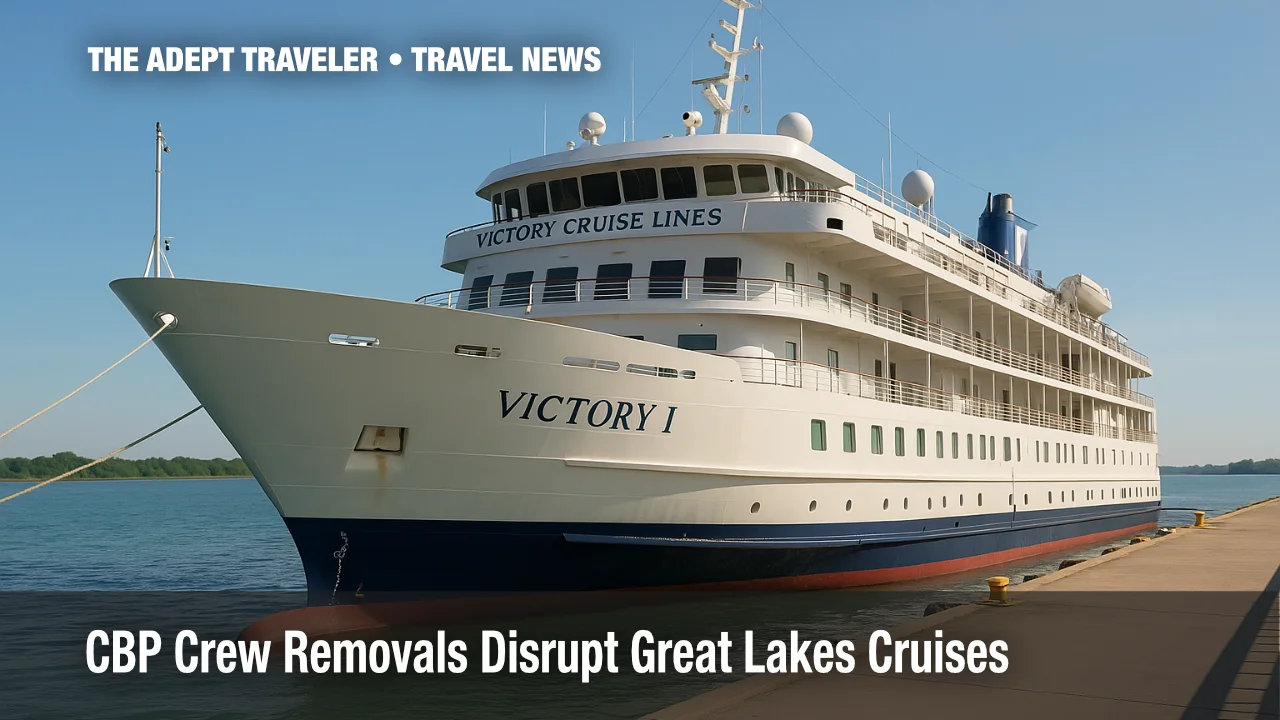CBP Crew Removals Disrupt Great Lakes Cruises

U.S. Customs and Border Protection (CBP) officers removed dozens of foreign crew members from at least five overnight cruise ships operating on the Great Lakes between July 9 and 11, 2025. The unannounced enforcement action affected vessels from Victory Cruise Lines, Viking, and Pearl Seas Cruises during scheduled calls in Detroit and other regional ports. While CBP has disclosed little about the ongoing investigation, the removals have already altered staffing plans, raised compliance questions, and unsettled a niche yet growing Great Lakes cruise market.
Key Points
- CBP took 13 crew off Victory Cruise Lines' Victory I and Victory II.
- Nine crew were removed from Viking's Octantis, 15 from sister ship Polaris.
- Pearl Seas' Pearl Mist also lost an undisclosed number of staff.
- Why it matters: Sudden crew losses can force itinerary changes, reduce service quality, and elevate costs for small-ship operators.
- CBP cites an "ongoing operation" but has not revealed specific violations.
Snapshot
Great Lakes cruises combine U.S. and Canadian ports on itineraries lasting seven to sixteen nights. Ships sailing these routes operate under U.S. immigration rules whenever they touch an American port, requiring crew to hold C-1/D seafarer visas and to clear inspection each time they enter. The vessels involved carry 180 to 378 guests and rely on lean hotel and technical teams. Even a small personnel hit can push onboard staffing below safe-manning levels, forcing cabins or venues to close until replacements arrive.
Background
Victory Cruise Lines resumed operations in spring 2025 after repurchasing its two ships from the defunct American Queen Voyages. Viking entered the region in 2022 with purpose-built expedition vessels, while Pearl Seas has sailed the lakes since 2014. All three lines use third-party agencies to recruit multinational crews who typically rotate on six- to nine-month contracts. Before the latest action, these workers had cleared U.S. immigration checks at the season's start and during every prior port call. Industry sources say large-scale crew removals in the Great Lakes have been virtually unheard of until now.
Latest Developments
CBP action and immediate fallout CBP officers boarded Victory II on July 9 and Victory I on July 11, escorting 13 crew ashore during routine clearance in Detroit. According to company chairman John Waggoner, each individual held valid documents and had passed earlier checks, yet was still required to disembark. The line quickly reassigned hotel staff from sister ships and shortened some shore-tour hours to maintain safety standards and guest services. No sailings were cancelled, but both ships now operate with slimmer entertainment and housekeeping teams.
Wider sweep across the lakes A crew member aboard Viking's Octantis reported that nine colleagues from food-and-beverage and deck departments were taken ashore the same week, while 15 more left the Polaris during a later stop. Pearl Seas confirmed to local port agents that CBP removed several workers from the Pearl Mist, although exact figures remain undisclosed. Cruise Lines International Association (CLIA) stated that members "cooperate fully with authorities" but declined to speculate on CBP's motives.
Operational and commercial strain Replacing specialty crew mid-season is difficult in the Great Lakes, where international airports can be up to 300 miles from small ports and cabotage limits restrict quick transfers from other ships. Operators have begun offering overtime incentives to remaining staff and are flying in relief personnel via Chicago and Toronto, often on costly last-minute tickets. Travel advisors report a spike in passenger inquiries about visa issues and itinerary stability, though few cancellations so far.
Regulatory mystery CBP describes the action only as part of an "ongoing operation." Neither the agency nor the Department of Homeland Security has issued a public advisory detailing alleged offenses, leaving cruise companies to investigate internally. Industry attorneys note that mass removals usually involve documentation discrepancies, criminal warrants, or suspected customs violations. Until facts emerge, lines are reviewing onboarding protocols and briefing crew on digital-device inspections, past pain points in earlier CBP crackdowns.
Analysis
For travelers, immediate impacts are modest-slower bar service, reduced daily programs, and occasional dining-room closures-but the incident underscores how U.S. immigration enforcement can ripple through an entire voyage. Small-ship lines lack the labor buffer of ocean megaships; losing even a handful of certified engineers or cooks can breach minimum safe-manning rules and force voyage truncation. Longer term, cruise operators may shift to U.S.-citizen hires for key posts, raise prices to cover recruitment costs, or rethink itineraries that include multiple U.S. ports in quick succession. The episode also highlights a regulatory gray area for the binational Great Lakes market, where ships must satisfy both U.S. and Canadian border agencies, sometimes on consecutive days. Greater transparency from CBP would help carriers adjust compliance practices without eroding guest confidence.
Final Thoughts
Victory, Viking, and Pearl Seas continue to sail, but the Great Lakes season now serves as a cautionary tale. Travelers should monitor pre-cruise emails for possible schedule tweaks, pack patience for leaner onboard staffing, and maintain flexibility with shore plans. Until CBP clarifies its findings, cruise lines will tread carefully, reinforcing documentation checks and contingency staffing to keep these uniquely North American itineraries afloat-crew removals or not, Great Lakes cruise crew removals remain the summer's defining headline.
